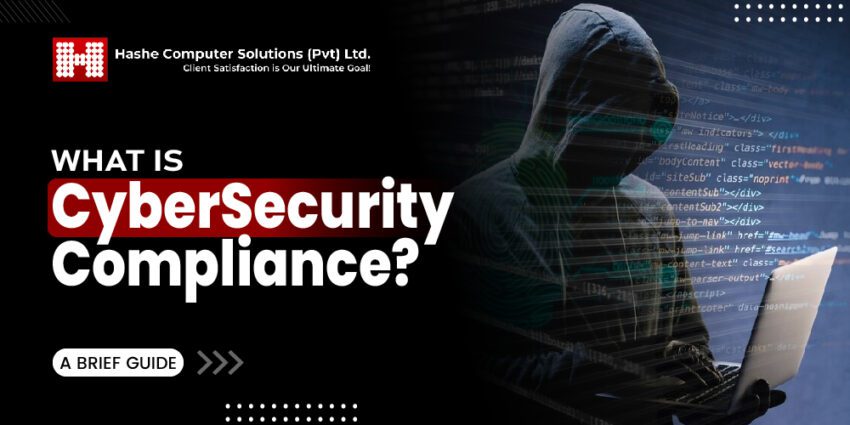
The business world is evolving swiftly, becoming increasingly technologically sophisticated and data-driven. Businesses and industries depend on massive volumes of data and information technology (IT) to increase efficiency, drive analytics, and streamline operations.
Numerous cyber threats have also emerged due to technological advancements, affecting individuals and businesses. In the wrong hands, the crucial data that drives our world can be misused to disrupt lives, steal identities, and drain bank accounts.
Cybersecurity compliance is essential because it helps firms create a comprehensive security program, encourages best practices, and establishes a strong security foundation. Nevertheless, navigating compliance can be highly challenging for companies.
This blog article explores the fundamentals of cybersecurity compliance, emphasizes its significance, and walks readers through important regulatory frameworks while providing insights on how companies can successfully align with these requirements.
What is Cybersecurity Compliance?
Any company that handles data, which most of them do, or has an edge exposed to the internet must take cybersecurity seriously. Organizations are at risk and susceptible to potential cyberattacks when they access and move data from one place to another.
Cybersecurity compliance is the systematic process by which businesses adhere to the guidelines and standards established by different regulatory agencies, authorities, or laws. Teams must adopt a risk-based strategy and establish policies that safeguard the three essential components of information: availability, confidentiality, and integrity (CIA).
These components serve as the cornerstone of information security. By attaining compliance, businesses show that they have put in place the defenses required to fend off cyberattacks and keep a solid security posture.
Cybersecurity compliance safeguards your company from cyberattacks. Common compliance standards such as ISO 27001, NIST, and SOC 2 offer safeguards to protect your data and systems against any vulnerabilities and breaches.
Significance of Cybersecurity Compliance
Cybersecurity compliance is critical for safeguarding sensitive data and an organization’s overall security posture. Here are a few main reasons why cybersecurity compliance is vital.
- Protection of Sensitive Data: Compliance guarantees that firms take strong security precautions to protect sensitive data from cyber threats, unlawful access, and breaches. It includes financial information, health records, intellectual property, and personal data, which, if compromised, might adversely affect both people and companies.
- Trust and Credibility: Businesses that follow established cybersecurity standards indicate a commitment to data security, gaining the trust of customers, partners, and stakeholders. Compliance implies accountability, improving a company’s reputation and edge over competitors.
- Risk Management: Frameworks for cybersecurity compliance offer an organized method for locating, evaluating, and reducing risks. These guidelines can help firms effectively manage and lessen their vulnerability to data breaches, cyberattacks, and other security issues.
- Legal and Financial Ramifications: Noncompliance can lead to significant legal penalties, fines, and financial losses. Organizations that fail to comply with cybersecurity regulations may face severe penalties from regulatory agencies globally. Long-term reputational harm might be even more expensive than the immediate financial consequences.
- Uninterrupted Operations: Compliance ensures that firms have the systems and controls in place to keep their operations running in the face of cyber attacks. Planning for business continuity and disaster recovery is part of this, as these are essential for reducing downtime and operational interruptions following a security incident.
- Enabling Global Business: Companies must adhere to both regional and global regulations to conduct business internationally. Non-compliance may limit a company’s capacity to interact with specific clients or conduct business in particular markets.
Types of Data Subject to Cybersecurity Compliance
Personally Identifiable Information (PII)
Personally identifiable information (PII) is any data that can be used to identify a particular person. It includes:
- Full name
- Social Security number
- Email address
- Home address
- Phone number
- Date of birth
- Passport number
- Driver’s license number
Financial Information
Financial information includes any data on a person’s or organization’s financial state or transactions. Since this type of data is frequently sensitive, it should be protected to avoid identity theft and fraud. Financial information includes:
- Bank account numbers
- Credit card numbers
- Credit history
- Income details
- Financial statements
- Loan information
- Investment details
Protected Health Information (PHI)
Protected Health Information (PHI) includes any data in a medical record that can be utilized to identify a person. This data was frequently created or referenced while providing healthcare services, like treatment or diagnosis.
PHI is protected by regulations such as the Insurance Portability and Accountability Act (HIPAA) in the United States, which establishes guidelines for the security of medical records.
PHI includes:
- Medical records
- Lab test results
- Insurance information
- Billing information
- Any other identifiable health information
How to Get Started with a Cybersecurity Compliance Program
Developing a cyber security compliance program and becoming compliant varies from company to company. However, the following general steps can help you begin your cyber security compliance program.
Creating a Compliance Team
Your company’s IT team is the major force behind cybersecurity compliance. Establishing a comprehensive compliance program requires the creation of a compliance team. All departments within a business must collaborate to maintain a strong cybersecurity posture and assist with compliance requirements.
Establishing a Risk Analysis Process
There are four fundamental steps in the risk analysis process, though naming conventions will differ depending on the compliance program:
Identify: It is necessary to identify any networks, assets, or information systems that access data.
Assess: Examine the data and determine the risk level for each type. Rate the risk of all points where data will pass over its lifecycle.
Analyze: Determine risk using this analysis formula: Likelihood of Breach x Cost or Impact.
Set Tolerance: Determine whether to mitigate, transfer, refute, or accept any identified risks.
Setting Controls to Manage Risk
Implement security controls that reduce or transfer cybersecurity risks. Cybersecurity control is a way to stop, identify, and lessen risks and cyberattacks. The restrictions can be physical, like fences and surveillance cameras, or technical, like passwords and access control lists.
These controls can be encryption, network firewalls, password policies, cyber insurance, employee training, incident response plans, patch management schedules, and access control.
Making Policies
After putting controls in place, you need to record any rules or regulations regarding these controls that IT teams, staff, and other stakeholders must abide by. Creating these regulations will also help with future internal or external audits.
Monitoring and Swift Response
It is critical to regularly assess your compliance program as new regulations are implemented or old standards are changed. A compliance program’s objective is to detect and control risks and stop cyber threats before they become serious data breaches. Establishing corporate procedures that enable prompt remediation in the event of an attack is also crucial.
Types of Cybersecurity Compliance Regulations
While many cybersecurity compliances are available, most businesses only deal with a handful.
The following are the eight primary cyber security compliance regulations.
PCI DSS
Payment Card Industry Data Security Standard (PCI DSS) consists of regulatory standards designed to ensure that all organizations maintain a secure environment for handling credit card information. To be compliant, organizations must validate their compliance on an annual basis.
Non-compliance with PCI DSS can result in significant fines, increased transaction costs, lost revenue, and damage to a company’s reputation. Businesses handling credit card data must take the required steps to guarantee adherence to the standard.
HIPPA
Enacted in 1996, the Health Insurance Portability and Accountability Act (HIPAA) is a federal law in the United States that protects the privacy and security of personal health information.
HIPAA requires healthcare providers, health plans, and other covered entities to use specific security measures to safeguard patient-protected health information (PHI) and maintain its confidentiality. This includes technical, administrative, and physical security measures such as password security, encryption, access controls, and regular security risk assessments.
HIPAA applies to all clearinghouses, health plans, and healthcare providers that electronically transfer PHI and any business partners with access to PHI. Failing to adhere to HIPAA regulations may lead to significant fines and legal repercussions.
SOC 2
Service Organization Control 2 (SOC 2) is a type of audit report that evaluates the measures and processes implemented by service organizations to protect customer data and information.
The Trust Services Criteria issued by the American Institute of Certified Public Accountants (AICPA) is the foundation for SOC 2. SOC 2 compliance includes criteria for privacy, confidentiality, processing integrity, security, and accessibility.
ISO 27001
The ISO 27001 standard outlines a set of recommended practices and processes that businesses can use to control information security threats and protect confidential data.
Businesses are required under the standard to develop and put into practice a process for identifying, assessing, and controlling information security risks. It also recommends that enterprises implement a series of security procedures to lessen these risks.
GDPR
The General Data Protection Regulation (GDPR) is a privacy and data protection policy that regulates how European Union citizens’ personal data is used, processed, and stored. It mandates that companies globally put in place the technical controls required to guarantee the data’s privacy, availability, and integrity.
GDPR promotes privacy by design, which necessitates a close integration of security into service design and secure execution. Additionally, it allows people to access, limit, or have their data deleted if necessary.
NIST
The National Institute of Standards and Technology (NIST) seeks to foster innovation, industry competitiveness, and quality of life through standard and technological developments. This voluntary standard for compliance can be customized to meet particular security needs and business scenarios.
NIST promotes five functions—protect, detect, respond, and recover—to help organizations reduce security risks. It focuses on risk-based cybersecurity management.
CCPA
The California Consumer Protection Act is another data privacy regulation that protects California consumers’ personally identifiable information. Companies must have measures to prevent unauthorized access to or disclosure of consumer information.
According to the CCPA, people have the right to refuse to have their personal information sold, and companies cannot discriminate against those who exercise this right.
CMMC
The US Department of Defense developed a compliance model called the Cybersecurity Maturity Model Certification. By safeguarding critical, unclassified information shared with contractors and subcontractors, it seeks to protect Defense Industrial Base (DIB) information security from cyberattacks.
Organizations handling national security information are required to adhere to the cybersecurity requirements established by the framework.
Wrapping Up!
Learning more about cybersecurity compliance is now more crucial than ever because cyberattacks are increasing, and new cybersecurity and data protection laws are being developed. No business wants to expose itself or its clients to the possibility of data breaches in a dangerous cybersecurity environment.
We hope this article gives you a clearer understanding of cybersecurity compliance and how specific compliance requirements impact your company.
Was this helpful?
Last Modified: February 18, 2025 at 10:18 am
17 views










